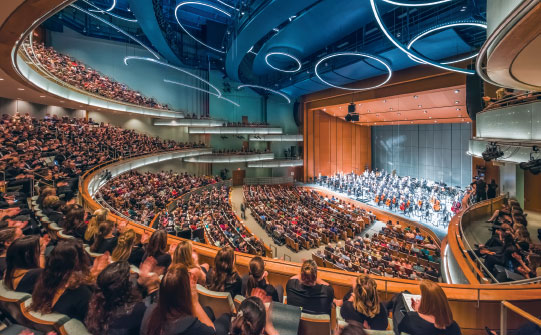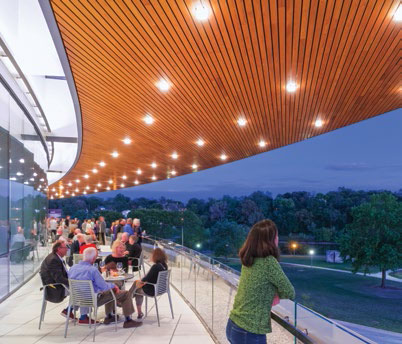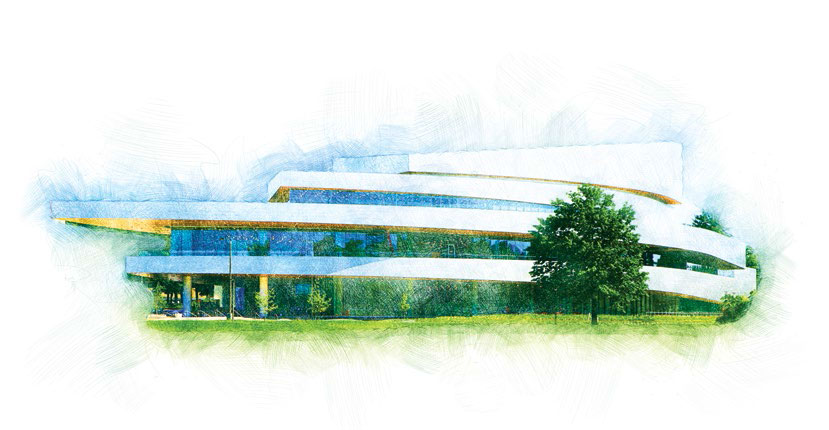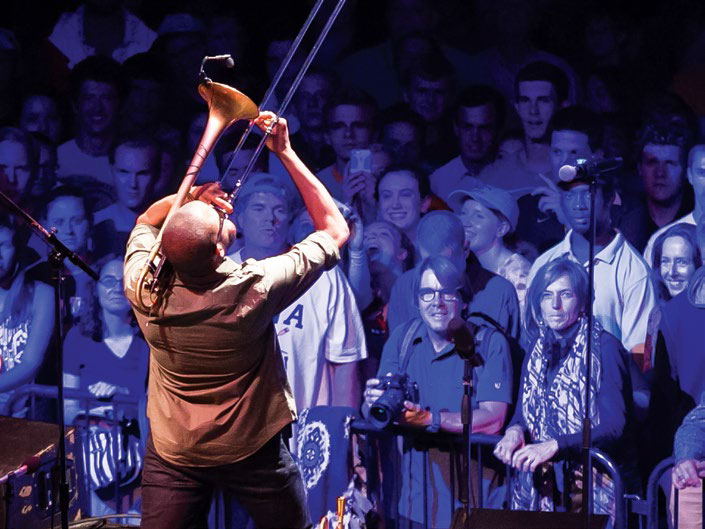L ike an ocean liner along the water, Hancher’s striking new stainless steel building lights up the Iowa River on a fall evening, as eager audience members clutch their tickets and fill the lobby. They have waited eight years to wear their best suits and sparkling evening gowns for this extraordinary opening night.
Excitement lingers as guests pour into the architectural masterpiece, stopping to take photos and relish in brass band music drifting down from the second-floor balcony. Proceeding up the grand staircase and into the intimate 1,800-seat auditorium, they join fellow patrons of the arts thrilled to mark an important milestone in University of Iowa history. Contrary to the name that headliners Steve Martin and Martin Short gave their performance—“An Evening You Will Forget for the Rest of Your Life”—playbill patrons say Hancher’s Sept. 24 reopening is a moment that will remain in their hearts forever.
 PHOTO: JEFF GOLDBERG
PHOTO: JEFF GOLDBERGTo celebrate the return of the beloved performing arts center, Hancher Executive Director Chuck Swanson, 75BBA, 76MBA, and world-renowned architect César Pelli walk on stage, praising the construction workers and community members who made the long-awaited event possible. “We have designed this theatre especially for you,” says Pelli. “This building was created with great love.”
After all the planning and rebuilding, Hancher has finally returned to its full glory. The inspirational building serves as a cultural beacon and symbol of resurgence for the UI arts campus, which debuted most of its new facilities this fall after being inundated by floodwaters in June 2008.
Hancher’s lights now dim as comedians Martin and Short amble onto the stage, set with two beige cushioned chairs and a piano. “You’re so lucky to be in this absolutely gorgeous theatre tonight. Congratulations!” quips Steve Martin, looking out into the seafoam-colored auditorium. “It’s been a longtime dream of mine to perform a two-man show here in Iowa City, and tonight I feel I have come one step closer to getting there. It’s more than a thrill—it’s an obligation.”
After inviting Swanson and other audience members onstage to dance in sombreros like the Three Amigos, the duo kicks off an uproarious evening of banter and banjos.
THROUGH THE FLOOD
 PHOTO: BRIAN RAY/CEDAR RAPIDS GAZETTE
PHOTO: BRIAN RAY/CEDAR RAPIDS GAZETTELike many in the audience that night, acclaimed artist Rinde Eckert, 73BM, has been a faithful friend of Hancher since its founding 44 years ago. Not only did he watch some of the most formative performances of his life in the original auditorium, but he also became a frequent guest to the Hancher stage. In 2008, Eckert returned to his native Iowa City to develop Eye Piece, an experimental play about vision loss commissioned by the performing arts center in collaboration with partners like the UI Center for Macular Degeneration. That summer, the Iowa River’s banks overflowed into the original Hancher Auditorium, submerging the stage, orchestra pit, and two-thirds of the rows of seating. The wooden floor buckled, and the red-velvet chairs that had adorned the theatre for 36 years became caked in sludge.
“I felt like a friend was gone,” Eckert says. “I wanted to be able to grieve the loss, but I couldn’t go back in and see it one last time.”
“THROUGH ALL OF THIS, WE LEARNED SO MANY THINGS THAT HAVE MADE US EVEN MORE CREATIVE AND RESILIENT.” -Chuck Swanson
Hancher staff scrambled throughout the summer to find venues to present its 2008-09 season, defiantly yet appropriately themed “Can’t Contain Us.” Though a few of the larger Broadway and dance shows were postponed or cancelled, Hancher staff members refused to let the lack of a building halt their artistic mission. With the help of the many longstanding partnerships Hancher had nurtured across the community and state, shows continued for the next eight years in venues ranging from area schools and churches to the Englert Theatre and Carver-Hawkeye Arena. The Hancher staff moved to a temporary headquarters at the Lindquist Center and later moved to Seashore Hall, with the box office operating out of the former Orange Julius location at Old Capitol Town Center. “We decided early on that Hancher is more than a building,” says Swanson. “Through all of this, we learned so many things that have made us even more creative and resilient.”
When the flood first hit, Hancher staff members entertained the possibility that they may be able to move back following some repairs. But after a months-long discussion between Federal Emergency Management Agency and U.S. Department of Homeland Security inspectors, the federal government ultimately ruled that the building couldn’t be saved and pledged to contribute millions towards the replacement of Hancher, the Voxman Music Building, and facilities for the School of Art and Art History.
Leading up to its demolition in fall 2013, the vacant Hancher looked as though it was on life support, with blue plastic tubes winding in and out of its belly to stabilize temperature. Spectators gathered at the Levitt Center and on a nearby hill to watch a large wrecking ball slowly knock away at the original structure. For Hancher director of marketing and communications Rob Cline, 92BA, 94MAT, witnessing the repeated blows to the center’s once-celebrated boxy concrete home was agony. “Hancher was a repository of a lot of memories for many people in our community,” says Cline, remembering where he went on school field trips as a child and later met his wife as a UI student usher. “The only thing that made [its goodbye] remotely bearable was the fact that we could simultaneously see the new building being constructed.”
By Design
Slowly, the new Hancher began to emerge just to the north of the former site, meeting FEMA’s rigid stipulations and 500-year flood criteria. OPN Architects principal and president Daniel Thies still has the champagne cork he popped in April 2010 when he learned that his local firm would oversee the project and ensure it met area building codes.
 BASED ON A PHOTO BY TIM SCHOON THE UNIVERSITY OF IOWA/OFFICE OF STRATEGIC COMMUNICATION
BASED ON A PHOTO BY TIM SCHOON THE UNIVERSITY OF IOWA/OFFICE OF STRATEGIC COMMUNICATIONOPN Architects helped select the world-renowned Pelli Clarke Pelli firm to design Hancher. Responsible for such stunning international landmarks as the Petronas Twin Towers in Malaysia and the World Financial Center in New York City, Pelli Clarke Pelli brought its expertise to make Hancher an accessible work of art. The architects created a “Hancher room” in their New Haven, Connecticut, office, wallpapering the entire space with images, drawings, and models of the center, the UI, and Iowa City. Out of their extensive research emerged a blueprint that reflected the rich history of the original auditorium, while updating the facility to meet modern standards.
Accustomed to designing performing arts centers in crammed urban environments, Pelli—considered one of the most influential architects alive—was instantly enamored with Hancher’s park location that featured extraordinary views of the river and campus. He designed Hancher’s cantilever, curves, and accents to echo the landscape and flow of the river, respecting the beauty of what once destroyed it.
From the Ground Up
For months on end, the vacant grassland next to the Levitt Center buzzed with construction activity like a miniature city as workers bulldozed and leveled the ground, pounded in the footings, poured concrete, brought in a towering crane, and took lunch breaks under the shaded trees of City Park.
For the 3,000 workers who invested one million hours to complete Hancher, the project meant much more than just another day on the construction site. Some came from as far away as Alaska to work on the complex and prestigious job, while others had personal connections to the area and were proud to tell their family about their role.
 BILL ADAMS/THE UNIVERSITY OF IOWA
BILL ADAMS/THE UNIVERSITY OF IOWAConstruction crews worked tirelessly on the project year-round, even clocking in 24 hours, six-and-a-half days a week during subzero temperatures in the winter of 2013-14 to maintain the project’s schedule. “Buildings like Hancher are wildly complicated and sophisticated,” says Thies. “It takes extraordinary thought, engineering, and creativity to pull off something that looks this elegant and simple. That’s the part that people never see.”
For every construction milestone, Hancher staff threw a celebration to help keep workers and the community invested in the center. One of those milestones came in October 2014 when the project reached the estimated halfway point of construction and Hancher invited the public to sign a steel beam that would forever be a part of the new building. More than 1,000 community members left congratulatory messages like “welcome back” and “to new beginnings” on the beam, which was raised into Hancher’s southern cantilever.
 PHOTO: JUSTIN TORNER/THE UNIVERSITY OF IOWA/OFFICE OF STRATEGIC COMMUNICATION
PHOTO: JUSTIN TORNER/THE UNIVERSITY OF IOWA/OFFICE OF STRATEGIC COMMUNICATIONIn summer 2016, construction workers put the final touches on Hancher, which involved acoustics experts popping balloons on stage and bringing in different-sized musical groups in order to test the theatre’s reverberations. After 2,800 days of performances on the road, the Hancher staff was ready to return home. Reflecting back on the arduous journey, Swanson says, “As excited as I am to open, there’s some sadness, too, because we’ve worked with a team of wonderful people who have become part of our extended family.”
THE RETURN HOME
Though the Steve Martin and Martin Short show was the first ticketed performance in the new venue, Hancher launched its comeback year with free public events leading up to opening night. More than 9,000 visitors walked past celebratory black-and-gold banners and into the new building for the first time during the open houses in mid-September, visibly in awe of the architectural masterpiece. Inside the lobby, the Quixotic Cirque Nouveau from Kansas City created a carnival atmosphere, where jugglers, stilt-walkers, and other avant-garde performers interacted with guests.
 BASED ON A PHOTO BY TIM SCHOON THE UNIVERSITY OF IOWA/OFFICE OF STRATEGIC COMMUNICATION
BASED ON A PHOTO BY TIM SCHOON THE UNIVERSITY OF IOWA/OFFICE OF STRATEGIC COMMUNICATIONDuring a formal dedication ceremony that weekend, government and university officials joined arts patrons onstage to reflect on Hancher’s return. “Chuck [Swanson] has done a fantastic job of bringing the world to us,” remarked Mary Jo Stanley, a major contributor who—along with her husband, Richard, 63MS—made the gift for Hancher’s Stanley Café. “It’s been a joy to see [the same caliber of shows] seen in Chicago and New York without having to go through all that traffic.
Iowa artists also returned to the stage for the first time in years. Former Broadway star Julius Carter, 07BA, explained how watching Dance Gala at Hancher as a UI student inspired him to become a professional actor and dancer. “Although New York and Los Angeles are known as places where dreams come true,” Carter says, “we need communities like Iowa City to ignite dreams and spark possibilities.”
Rinde Eckert’s homecoming was like reuniting with a cherished friend. “This stage is completely naïve. It doesn’t know what it’s in for,” he joked. Later, Eckert joined Iowa City native and professional pianist Conor Hanick for a stirring rendition of “The Impossible Dream (The Quest)”—met with one of the theatre’s first standing ovations. The Community Mass Choir followed with a melodic wish: “Bless this door that it may prove ever open to joy and love.”
A COMMUNITY EFFORT
Two weeks after the dedication ceremony, audience members exuded joy as they exited the inaugural Steve Martin and Martin Short show. They gathered on Stanley Café’s balcony after the hilarious performance, spilling out into the lobby and outdoor patio for a champagne social. Outside, performers juggled fire and rappelled off the roof as flashing beams of blue light put the spotlight on Hancher. Then—in one of the biggest surprises of the night—a fireworks finale erupted over the field where the old auditorium once stood, placing a storybook ending on Hancher’s opening act. BASED ON A PHOTO BY TIM SCHOON THE UNIVERSITY OF IOWA/OFFICE OF STRATEGIC COMMUNICATION
BASED ON A PHOTO BY TIM SCHOON THE UNIVERSITY OF IOWA/OFFICE OF STRATEGIC COMMUNICATIONOLD MEETS NEW
A $175 million project, the impressive new Hancher building includes:
Reaching Out
In the flood, Iowa City could have lost what former UI President Sandy Boyd, 81LHD, called “the largest classroom on campus,” where audiences and performers regularly had transformational artistic experiences through world-class dance, music, and theatre. However, Hancher’s mission has always been to reach beyond its doors to engage thousands of Iowans across the state in the performing arts. Hancher not only opens its doors to the public each season, but also ventures out to provide more than 100 free educational programs to communities across the state. These efforts have only increased in recent years with the introduction of a new public engagement coordinator and education manager, who help bring artists into K-12 and college classrooms for workshops, performances, and panels. About half of this season’s Hancher performers will spend anywhere from a day to a week meeting with students. In the case of the special preview performances of Joffrey Ballet’s new Nutcracker, dancers will extend their stay even longer to train and rehearse with local children featured in the production. Hancher has also been transformative in the lives of the artists who have graced its stage over the years. Since 1986, the performing arts center has commissioned more than 100 new works. This includes support for the 1987 Hancher world premiere The Nutcracker, plays from the Iowa City-based Working Group Theatre that explore topics such as bullying and social justice, and original music from the San Francisco-based Kronos Quartet.
Hancher Timeline
BEHIND THE ART
Watch the following videos for more on the local and international artwork featured inside Hancher:

